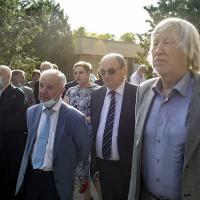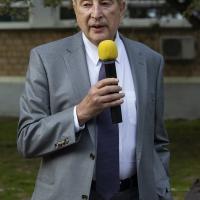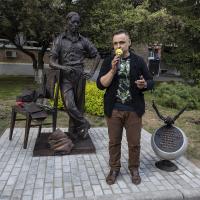On May 25, National Research Nuclear University MEPhI held the grand opening of the monument to Professor of MEPhI, Nobel Peace Prize Laureate, and Academician Andrei Sakharov in honor of his centenary.
In 1949-1950, Academician Andrei Sakharov (1921-1989) worked at MEPhI. The scientist was one of the creators of the USSR hydrogen bomb; he researched magnetohydrodynamics, plasma physics, controlled thermonuclear fusion, elementary particle physics, astrophysics, gravity, cosmology. He explained the emergence of the inhomogeneity of the distribution of matter from the initial density perturbations in the early Universe, which have the nature of quantum fluctuations.
In 1950 A.D. Sakharov and I.E. Tamm proposed the idea of implementing a controlled thermonuclear reaction based on magnetic thermal insulation of plasma for energy purposes. In particular, they have considered the toroidal configuration in stationary and non-stationary versions; today it is recognized as one of the most promising. In 1975 A.D. Sakharov was awarded the Nobel Peace Prize.
The ceremony was attended by employees and students of MEPhI, representatives of the State Atomic Energy Corporation ROSATOM, institutes of the Russian Academy of Sciences. First Vice-Rector of MEPhI Oleg Nagornov said that A.D. Sakharov made a great contribution to the development of the university.
— In 1950, Andrei Sakharov, together with his teacher Igor Tamm, made an assumption and put forward the idea of a controlled thermonuclear reaction based on the principle of magnetic thermal insulation of a plasma. Their idea of a tokamak (a toroidal chamber with magnetic coils) is still considered promising for problems of controlled thermonuclear fusion. The vice-rector of MEPhI also paid attention to Andrei Sakharov’s contribution to the creation of a treaty banning nuclear tests in the atmosphere, in outer space, and underwater.
The history of the Russian Federal Nuclear Center of the Research Institute of Experimental Physics (RFNC-VNIIEF) is closely connected with the name Andrei Sakharov. The honorary scientific director of the RFNC-VNIIEF Radiy Ilkaev recalled that during the Cold War, the young physicist Andrei Sakharov was one of the leaders of domestic nuclear physics and weapons development. “In this sense, the merit of Andrei Dmitrievich Sakharov to our country, to our people, of course, is tremendous,” R. Ilkaev emphasized.
According to Eduard Lozansky, a professor of MEPhI and President of the American University in Moscow, Sakharov's ideas unite scientists from different countries:
— About 20 years ago, a monument to Academician Sakharov was erected in Washington, and now it has appeared in Moscow. Today, scientists from Russia and the United States are discussing Sakharov's ideas related to solving the global energy problems of humanity, he stressed.
The sculptor of the monument, Alexander Mironov, spoke about the history of its creation:
— It was not by chance that I chose a period in his life when he young when he receives his awards, prizes, titles when he is full of energy, plans, and prospects. Next to the scientist is a dove of peace, hovering over the slice of a symbolic globe — an eternal reminder for future generations, for you and me, that the world is unstable and fragile. We must always remember this.
The Sakharov Monument became part of the Alley of Nobel Laureates, founded on the territory of MEPhI in 2017 in memory of six Nobel Prize winners who studied or worked at university. The project's main sponsor and ideological inspirer is a MEPhI graduate, General Director of Artplast Company Andrey Novikov. The task of the Alley of Nobel Laureates project is to pay tribute to Russian scientists, to popularize science, he stressed.

















